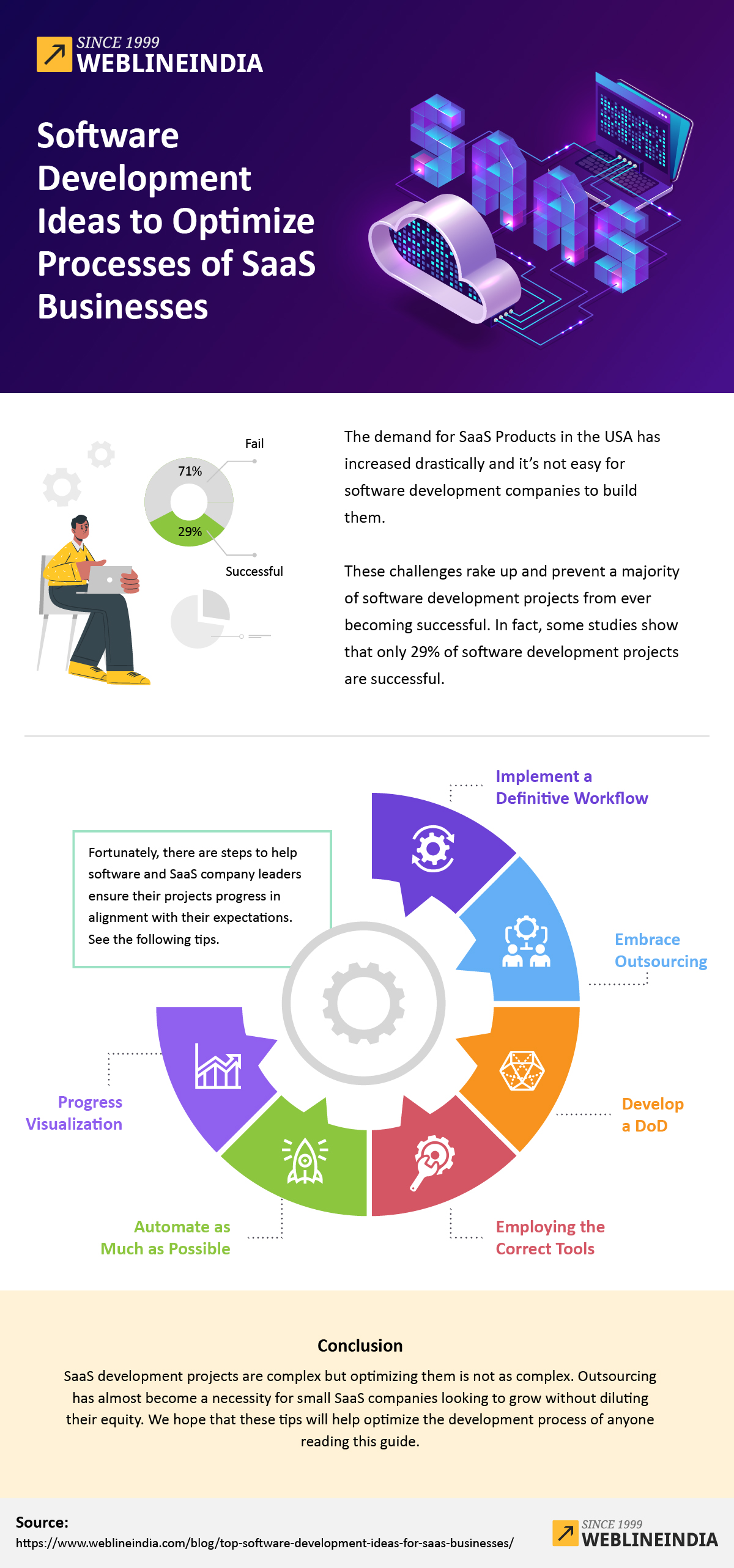
The demand for SaaS Products in the USA has increased drastically and it’s not easy for software development companies to build them. Besides the obvious need for incredible development talent, the process also demands excellent management from project managers. Developing products that customers can find useful requires synchronous contributions from several professionals, each with a different set of expertise. Such projects also demand a considerable investment in terms of time and money.
Keeping a team together and maintaining output consistency is tricky. And, this daunting task may become even challenging when it needs to be done every day for weeks and months. Add time and budget-related constraints and unforeseen development hiccups to the mix, and it becomes evident why SaaS development can be an administrative nightmare.
These challenges rake up and prevent a majority of software development projects from ever becoming successful. In fact, some studies show that only 29% of software development projects are successful.
Fortunately, there are steps to help software and SaaS company leaders ensure their projects progress in alignment with their expectations. These tips and steps are discussed in the upcoming sections of this article.
Without further delay, let’s jump right in.
1. Implement A Definitive Workflow
SaaS development processes are complex, and most tasks cannot be categorized as ‘done’ or ‘not done. Most tasks that lead up to the development of a finished product have multiple stages where different members of the team are contributing to the completion of the task.
To ensure that long-term development projects are progressing on time, having a workflow can make a significant difference. To define it in simple terms, workflow is a set series of steps that a company or team takes to complete a task. If a company or team works on a single kind of project, they can build a standard workflow that applies to all their projects. An excellent example of this may be a web development company that works within a specific industry, like developing websites for marketing agencies.
Since most websites will have similar attributes and features, a single workflow can be implemented so that all projects are completed without hiccups, and the quality of the finished websites is consistent.
On the other hand, you may need to contact software development companies in the USA that offers custom software solutions to develop a workflow for each project.
Regardless of the context, a workflow will bring clarity to the development process. It will also ensure that no critical steps are missed. For instance, if testing each new feature after coding is complete is a desired step, it can be included in the workflow, so everyone in the team is aware of the step.
It is important to note that most teams will have to do at least a little bit of trial-and-error before coming up with a workflow that works for them. However, once a workflow is implemented, it will reveal its flaws, and the insights can be utilized to streamline it for better output.
2. Embrace Outsourcing

In the software development world, outsourcing has become a significant trend. However, it has been popularly used by software development companies in the USA and worldwide for such a long time that it may have evolved from being a trend to being an industry-wide practice, and for a good reason.
Outsourcing, when done right, can solve a myriad of challenges and problems associated with the development process. Some of the expected changes that outsourcing solves include staffing issues and a lack of in-house expertise.
Outsourcing enables small SaaS developers teams to develop valuable products that use technologies beyond the scope of the team’s core expertise. Any development business, be it a SaaS company or a custom software development company in the USA, can benefit from outsourcing. It reduces the strain on the internal team, which further enables project managers to make the development process a breeze. By incorporating process workflow automation, small companies can seek help from outsourcing partners to scale their operations, and big companies can use them to become more cost-efficient. Not to forget, there are apparent time-related benefits of expanding any team, regardless of the company’s size.
With that said, outsourcing projects or parts of a project does not always go according to plan. In most cases, a bad experience with outsourcing can be attributed to not choosing the right partner. Therefore, outsourcing partners should be evaluated using all necessary parameters.
The obvious ones include:
- checking reviews and portfolios,
- enquiring about the experience and the expertise of the team of the outsourcing company, and
- looking at their completed projects.
It is also a good idea to ask for client references.
Besides these, it is also recommended to ask the outsourcing partner to send across the professional profiles of the individual developers that will be assigned to the project in question. The project manager should interview these individual developers to ensure they genuinely possess the expertise and experience required to bring the project to a satisfactory completion.
It is important to remember that software development is a lucrative business line, and many players offering software development services have entered the space. Thorough research is perhaps the only way for business leaders to protect their interests when they outsource to external partners.
Read related post on Software Development Outsourcing
3. Develop A DoD
A ‘Definition of Done’ or DoD is a set criterion that defines whether or not a task is indeed done. Because of the multi-stage nature of software development projects, the implementation of DoD makes much sense.
When defining what is “done” in terms of software development, it is recommended to define a set of rules that a task must fulfill to be considered done. Doing this will help eliminate the ambiguity in the development process. It also ensures that all members of the team are on the same page at all times.
The importance of DoD is explained with the help of an example below:
Suppose a project manager asks a developer whether or not the development of the feature is complete. The developer who has completed the core programming of the feature may reply with a ‘yes.’ However, despite the core code is set, the element may not be ready to launch for the user. Essentially, while a developer may consider completing the core programming enough to ‘complete’ the task, it is not really complete unless the feature is ready for a rollout.
Having a well-defined DoD also reduces the frequency of back and forth communication between the development team and the quality analysis (QA) team. For example, it is common to see quality analysts reopening a completed task because they find issues in the testing stage. To avoid this situation, everyone in the team should complete the task after getting the green light from the QA team.
Implementing a thorough DoD may increase the initial time taken to ‘complete’ a task. However, development teams can save more time by avoiding reopening a completed task because of unmet criteria.
Once a DoD has been defined, it should be shared with the entire team to ensure everyone knows the relevant rules. For example, if a team is working with an outsourcing partner that offers software development services, it is advisable to share the DoD rules with the entire extended team, including the external resources.
4. Employing The Correct Tools

Just like it is essential to have the right talent on a development team, it is equally important to empower team members with the right tools for the job. This may include work management tools and communication tools, besides the specialized tools that developers may need to do their actual job.
Most business leaders already understand the importance of a dependable work management tool. However, the importance of a trusty communication tool is often overlooked, and that can prove to be a grave mistake. This is especially true in today’s scenarios when distributed teams are becoming more and more common. A good communication tool is important to keep the development team tightly bound together and members on the same page. Its importance is even more vital for teams that are working with external outsourcing partners.
Also read, our post on Custom Software Development Cost
5. Automate As Much As Possible
In the traditional sense of the word, automating software development isn’t possible. However, with process automation, you can streamline certain aspects of the workflow, taking the weight off the shoulders of developers. For instance, you can use repeating scripts to reduce the need for manually testing features. Using this method is a little time-consuming, it demands no active involvement from the development or quality testing resources. This gives custom software developers the freedom to work on new features.
When time is available, it is also a good idea to employ user testing instead of automated or manual testing. This allows development teams to roll out a product quickly and get complete feedback on the product.
It is also a good idea to implement workflow automation tools. Such tools, like Zapier, can eliminate the need to perform repetitive tasks manually. This will also help development teams save up to one hour of productive time every day.
6. Progress Visualization

Progress visualization may seem like a minor detail. However, in reality, it can go a long way in boosting the productivity and efficiency of any development team. Besides giving the team a holistic view of the project status, progress visualization can help in boosting the team’s morale. It will also help eliminate redundancies and avoid miscommunication among the different members of the team.
Progress Visualization is commonly known as an information radiator. This is a work status visualization setup that can help managers identify bottlenecks and actively work on eliminating them. It will also tell the project manager about the blocked tasks, helping them be more efficient with delegation.
The important benefit of progress visualization is that it will help the team identify problems in their initial stages. In addition, the information radiator is visible at a place where anyone can view it. This will spark conversation around these problems, which may lead to viable solutions.
The most crucial aspect of implementing data visualization to optimize the SaaS development process is to choose the right tool. Ideally, a tool that can record and visualize information from a variety of perspectives is perfect for the job. In addition, it is important that a tool allows continuous and real-time display of data. Unfortunately, several data visualization tools don’t offer these features (example: Jira) and may need additional APIs to serve this purpose.
Also, read the blog on Prompt Engineering in Software Development
Conclusion
SaaS development projects are complex but optimizing them is not as complex (in comparison). Good habits, like a well-defined workflow & DoD, can go long way towards ensuring better efficiency and production quality projects. Software leaders also must understand that outsourcing is not a luxury anymore. With outsourcing, even a small software development company in the USA can enjoy the advantage of having a large team on its side. Outsourcing has almost become a necessity for small SaaS companies looking to grow without diluting their equity.
We hope that these tips will help optimize the development process of anyone reading this guide.
Frequently Asked Questions
Here are 6 ways it can help your business:
– Mobile Service Management can help you increase productivity
– Using a Customer Database to manage clients
– Using Service Reminders to generate repeat business
– Improve Customer Service
– Improve Scheduling
– Electronic Forms and Documents help to reduce waste
The steps to creating a successful SaaS product are as follows:
Step 1: Research the market
Step 2: Create a business plan
Step 3: Define the needs for SaaS
Step 4: Pick a technological stack
Step 5: Assemble your group
Step 6: Create an MVP
SaaS is a methodology for software distribution in which a cloud provider hosts programs and makes them available to end-users via the internet. In this case, an independent software vendor (ISV) may hire a third-party cloud provider to host the application.
JavaScript is the most popular programming language for SaaS applications and it is suitable for both front-end and back-end development.
The cost-effectiveness of SaaS-based software has remained one of the primary benefits of SaaS-based software in the information age. It also cuts TCO (Total Cost of Ownership) and increases margins for B2B and B2C organisations.
Social Hashtags
#saasbusiness #softwaredevelopment #softwaredevelopmentsolutions #customsoftwaresolutions #softwaredevelopmentcompany #businesses #softwaredevelopmentIdeas #itstartup #itcompany
Software Development Ideas for SaaS Business: INFOGRAPHIC

Testimonials: Hear It Straight From Our Customers
Our development processes delivers dynamic solutions to tackle business challenges, optimize costs, and drive digital transformation. Expert-backed solutions enhance client retention and online presence, with proven success stories highlighting real-world problem-solving through innovative applications. Our esteemed clients just experienced it.









